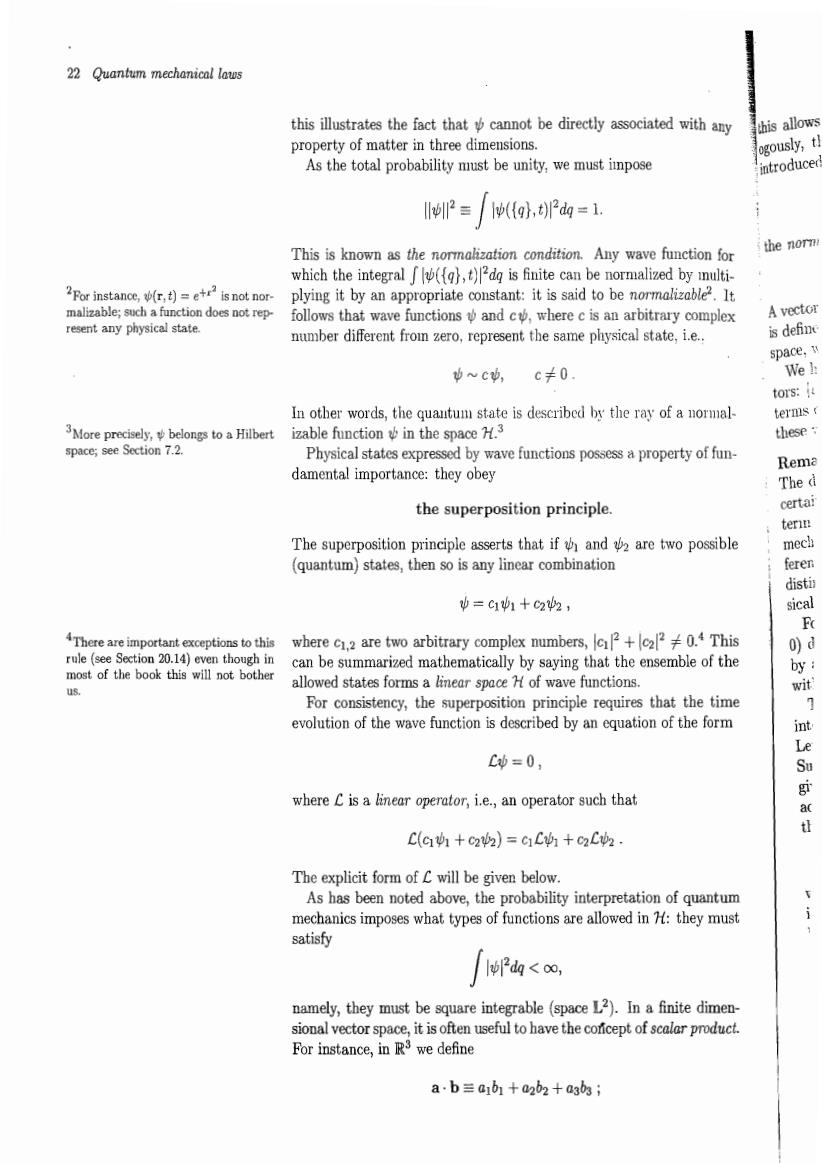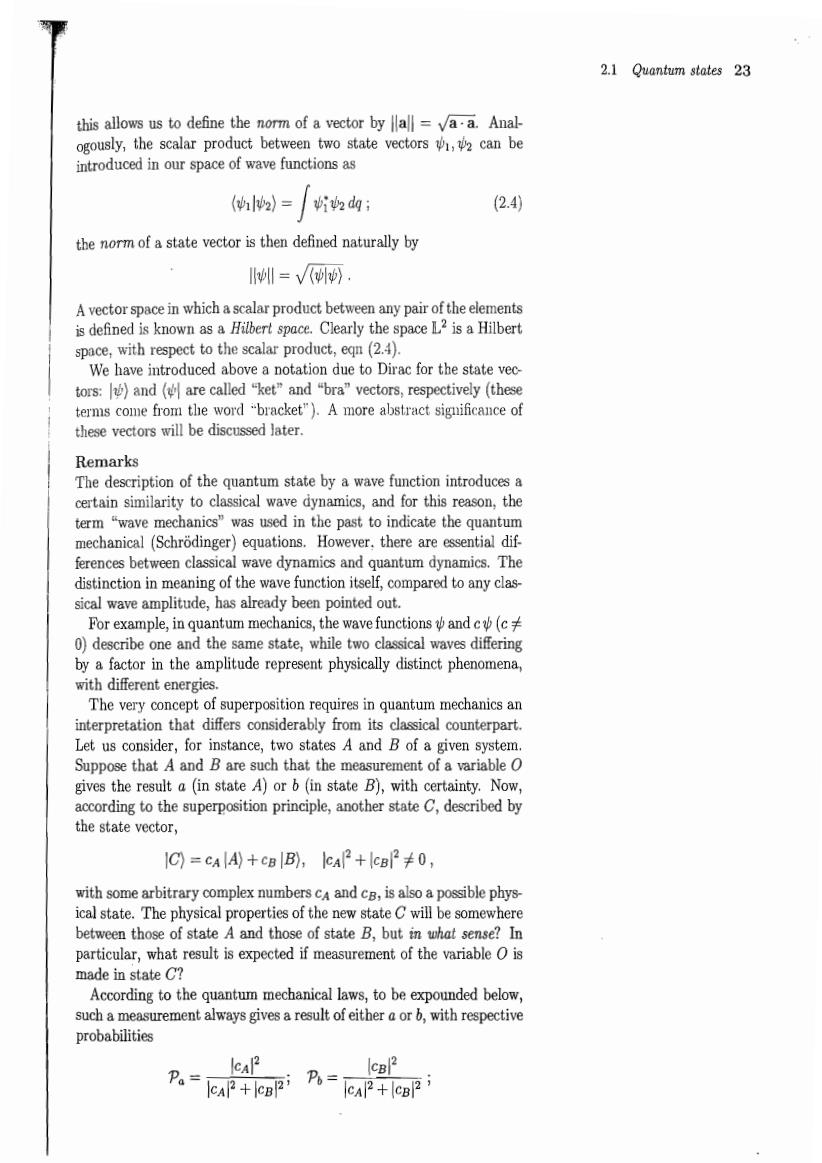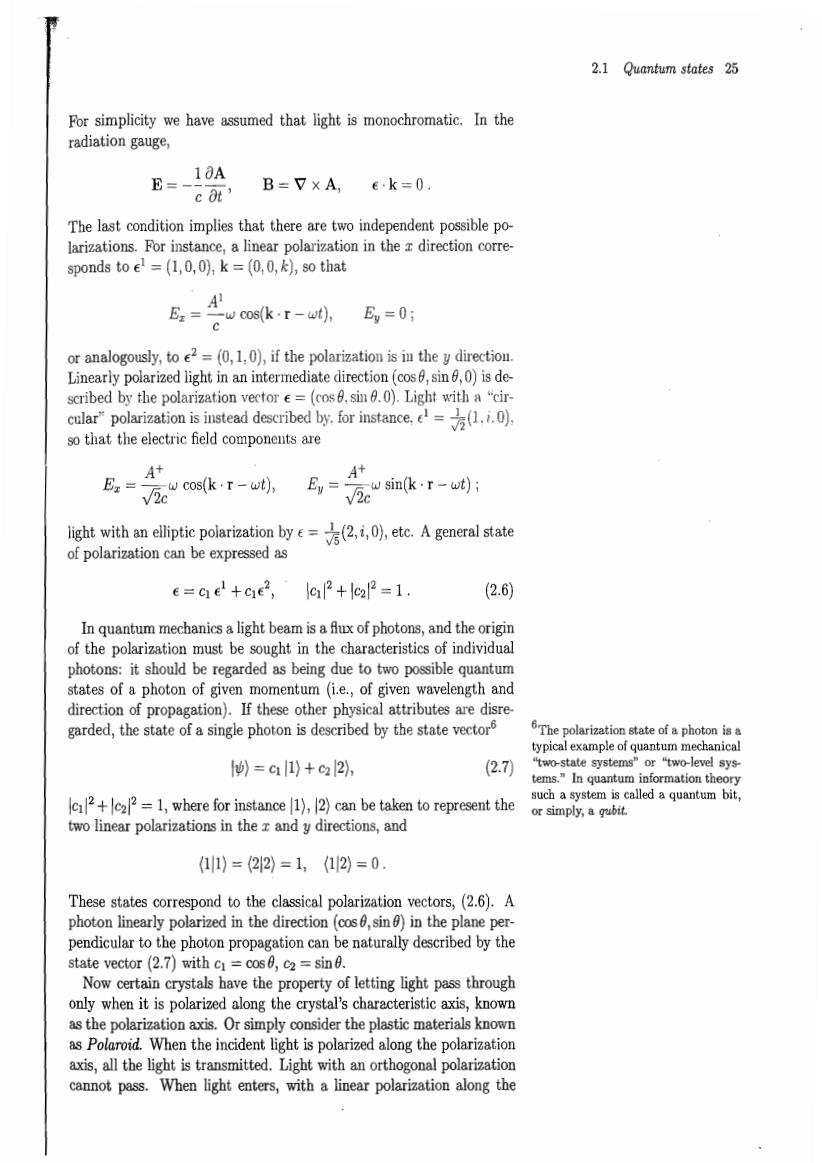
22 Quantum mechanical lous this illustrates the fact thatcannot be directly associated with any this allows property of matter in three dimensions. As the total probability must be unity,we must impose 2=({q,t2d=1 This is known as the normalization condition.Any wave function for the norm which the integralt)dg is finite can be normalized by multi- 2For instance,(t)=is not nor plying it by an appropriate constant:it is said to benormaliIt follows that wave functions中andc地,where cisan arbitrary complex A ve space, c¥0 We tors: In other words,the quautum state is described by the ray of a normal- terms izable function in the space H.3 these space;see Section 7.2. Physical states expressd by wave functions posessa property of fu- damental importance:they obey Rem The d the superposition principle. certa! mec dist 中=c11+c2, sical 4There are important exceptions to this where c1 are two arbitrary complex numbers,c+c220.This 0) can be summarized mathematically by saying that the ensemble of the allowed states formsa iner spaceH of w e functions sition ciple r requires that the time C地=0, where C is a linear operator,i.e.,an operator such that t C(q4+c2)=G9C的+2C的 The explicit form of C will be given below. As has been noted above,the probability interpretation of quantum mechanics imposes what types of functions are allowed in they must satisfy lopdq<oo, namely.they must be square integrable (space l).In a finite dimen sional vecto space,it is often useful to have the coficept of scalar product For instance,inRwe define ab≡ab+a2b2+ag

2.1 Quantum states 23 this allows us to define the norm of a vector by all =aa.Anal- scalar state vectors can be aced in our space e of wave (2.4 the norm of a state vector is then defined naturally by =√(胸 A vector space in which a scalar product between any pair of the elements is defined is known as a Hilbert space.Clearly the space L2 is a Hilbert space,with respect to the scalar product,(2). We have introduced above a notation due to Dirac for the state vec Remarks The description of the certain similarity to ouantum state by ea al wave dynami term wave me was us in t e past toindicate the qu mechanical (Schrodinger)equations.However,there are essential di ferences between classical wave dynamics and quantum dynamics.The distinction in meaning of the wave function itself,compared to any clas- sical wave amplitude,has already been pointed out. For example,in quantum mechanics,the wave functionsandcc 0)describe one and the same state,while two classical waves differing by a factor in the amplitude represent physically distinct phenomena with different energies. The very concept of superposition requires in quantum mechanics an interpretation that differs considerably from its classical counterpart. Let us consider,for instance,two states A and B of a given syst Suppose that A and B are such that the measurement of a variable O vethe rea(in state利orbstae,ithcertainty.Now ng to the the, superposition n principle another state C.described by IC=caA+cBB,eaP+lcgP≠0, with some arbitrary complex numbers cA and cB,is also a possible phys ical state.The physical properties of the new state C will be somewhere between those of state A and those of state B.but in what sense?In particular,what result is expected if mea surement.of the made in state C? According to the quantu mechanical laws to be unded belot tremen P.=eAP+cP

24 Quantum mechanical laws no other results are possible,even if the variable O may a priori take For sin other possible values.The intermediate character of state C thus ex. presses itself through the probability of a particular result for an obser vation being intermediate between the corr esponding probabilitiesfor the original states.not through the result itself being intermediate betwe the co mding results for the o inal states(apas sage quoted ver batim from 84 of Dirac's book Dirad c(1958) The la larizat spond: 2.1.1 Composite systems In a system composed of two for more)non-interacting and uncorrelated subsystems A and B.the wave function takes a factorized form or an 中A.B=A的B (2.5) Linea ective states of the two sub scrib btherefiecting the independence o the two subsystems.Such is,of course,a very reasonable assumption so t to make in any sensible theory.The success of quantum mechanics in many practical applications indicates that the factorization property, (2.5),generally holds with very high precision. On the other hand,in quantum mechanics,the wave function for sys tems involving identical particles(many electrons,many protons,etc.) ligh must obey certain symmetry properties with respect to the exchange ofp of identical particles.Such a requirement-called Bose-Einstein (BE) or Fermi-Dirac(FD)statistics-introduces a characteristic correlation among the particles of the same kind,even when the interactions among them are negligibly weak.Bose-Einstein or Fermi-Dirac statistics have of far-reaching cor quences in all applications of quantum mechanics from elementary particle,nuclear,atomic,and molecular physics,to con densed matter physics and astrophysics.. di More even acted in the p nt,two (o ga ally hibit defnit cha ain circumst ce t characte d qu antum entang ment,m 5The standard theory of the fundamer estthemselve even when the separate causally interac in the pres uture times The corre ons occur in an apparently al an Glashow-Salan gcctroh non-causal fashion,in glaring contrast to the fact that fundamental interactions-strong and electroweak interactions-are described by a ausak it is k to describe Nature local and causal theory to an impressively high precision. These ex- traordinary aspects of quantum mechanical correlations will be discussed tance in Part Iv of this book. 2.1.2 Photon polarization and the statistical nature of quantum mechanics The polarization of light is described,in classical physics,by the polar izationvecto(k)which characterizes A=A(k)e(k)eik-r-tsut +c.c

2.1 Quantum states 25 For simplicity we have assumed that light is monochromatic.In the radiation gauge, E=-10A B=V x A, e.k=0 The last condition implies that there are two independent possible po larizations.For instance,a linear polarization in the direction corre sponds to =(1,0,0),k =(0,0,),so that E= -w cos(k.r-wt),Ey=0 or analogously,to=(0,1,0),if the polarization is in the ydirection Linearly polarized light in an intermediate direction (cs,sin0)is de scribed by the polarization vector e=(cos0.sin.0).Light with a "cir- cular"polarization is instead described by.for instance.(1..0). sthat the electric feld components are coo(kr-wt),E sin(kt); light with an elliptic polarization by,),etc.A general state of polarization can be expressed as lg2+lc22=1 (2.6 must be ght in the char eristics of individual t should be tates of a photon tion of propag) p 2.7 or "two-leve sys +=1,where for instance 1),2)can be taken to represent the or simply,a gubit. two linear polarizations in theand ydirections,and 11)=22)=1,(12)=0. These states correspond to the classical polarization vectors,(2.6).A photon linearly polarized in the direction (cos0,sin)in the plane per pendicular to the photon propagation can be naturally described by the state vector (2.7)with c =cos0,c=sin0. Now certain crystals have the property of letting light pass through only when it is polarized along the tal's character xis.kn as the yder the terials kr ght is pola ng th po an orth cannot pass. When light enters,with a linear polarization along th

26 Quantum mechanical laws 10=10)cos2, 2.8 4 known as Malus'law. These u Consider now the physics of this beautiful empirical law,from the state in te quantum mechanical point of view.If the incident photon has the ap of Gaussi propriate polarization(say,1)),it passes.If it has the wrong polariza tion (ie..2)),it does not.What hap ens to an incident photon that is (by the statevect The dist |均=cos81)+s血912 A photon,with a definite eergy.caot split.There are no other options left:it must either pass or not pass.The only sensible answer As atre: to the above question is that such a photon has some probabilty of pass- of e.g. ing and some probability of not passing.If we assign the probabilities The P+=Ic2=cos2 0 (of passing)and P_=Ic22=sin20 (of not passing) Indeed then for light beam consisting of many photons with the same polariza- tion,the number of photons which have passed through the crystal will v(c)- be 1(0).cos20 if /(0)is the number of incoming photons.We have thus derived Malus'law for the intensity of transmitted light(which is obvi- ously proportional to the number of photons which have passed through Accor the crystal)from quantum mechanics! a dec We see clearly that the probabilistic interpretation of quantumme- wave chanics is a direct.conse ence of certain em whe 2.2 The uncertainty principle The fact that the electron is described as a kind of wave means that the classical concept of particle trajectory no longer makes sense.An 90 electron cannot simultaneously have a definite position and momentum. It is not claimed that the concept itself of either particle position or par ticle momentum loses meaning.Rather the description of the physical state in quantum mechanics is no longer equivalent to the collection of 夕 At the same time.hov the laws of quantum chanics must reduce to those echanics in the e the onstanth can onsidered to be negligibl ignal the nain he natical expre y Heisen berg.Let us suppose that we are going to mea sure the position and momentum of a particle.The measurement will be done with a certain resolution,△r.and△,for each component.Heisenberg's uncertainty